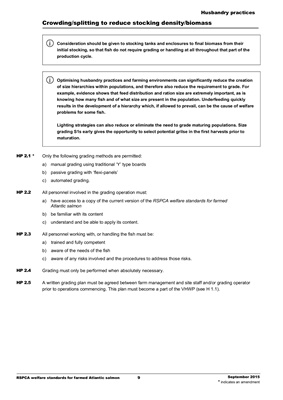
Husbandry practices
RSPCA welfare standards for farmed Atlantic salmon 9 September 2015
* indicates an amendment
Crowding/splitting to reduce stocking density/biomass
Consideration should be given to stocking tanks and enclosures to final biomass from their
initial stocking, so that fish do not require grading or handling at all throughout that part of the
production cycle.
Optimising husbandry practices and farming environments can significantly reduce the creation
of size hierarchies within populations, and therefore also reduce the requirement to grade. For
example, evidence shows that feed distribution and ration size are extremely important, as is
knowing how many fish and of what size are present in the population. Underfeeding quickly
results in the development of a hierarchy which, if allowed to prevail, can be the cause of welfare
problems for some fish.
Lighting strategies can also reduce or eliminate the need to grade maturing populations. Size
grading S1s early gives the opportunity to select potential grilse in the first harvests prior to
maturation.
HP 2.1 * Only the following grading methods are permitted:
a) manual grading using traditional 'Y' type boards
b) passive grading with 'flexi-panels'
c) automated grading.
HP 2.2 All personnel involved in the grading operation must:
a) have access to a copy of the current version of the RSPCA welfare standards for farmed
Atlantic salmon
b) be familiar with its content
c) understand and be able to apply its content.
HP 2.3 All personnel working with, or handling the fish must be:
a) trained and fully competent
b) aware of the needs of the fish
c) aware of any risks involved and the procedures to address those risks.
HP 2.4 Grading must only be performed when absolutely necessary.
HP 2.5 A written grading plan must be agreed between farm management and site staff and/or grading operator
prior to operations commencing. This plan must become a part of the VHWP (see H 1.1).
i
i